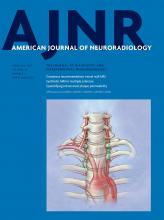We read with great interest the study of Benson et al,1 which demonstrates that CT perfusion has low sensitivity and high specificity in identifying lacunar infarcts. However, we believe that some clarification on the topic might be useful. Lacunar infarcts are defined as small subcortical infarcts (<15–20 mm) normally located in the basal ganglia, thalamus, internal capsule, corona radiata, and brain stem, which result (usually presumed rather than demonstrated) from the occlusion of a single penetrating artery of the brain.2 The etymology of the word “lacune” dates back as early as 1838,3 and since then, many different definitions have been proposed. Unfortunately, there is currently still considerable confusion about the real pathogenesis of these lesions.2 It is striking that the concepts attached to lacunes have only recently aroused interest.
The precise diagnosis of lacunar infarction due to small-vessel disease is tricky in clinical practice because the nature of the vascular lesion itself can only be determined by neuropathologic examination. In clinical practice, the diagnosis relies on the following: 1) probability assumptions based on the clinical features, 2) neuroimaging of the brain parenchyma, and 3) ancillary investigations such as ultrasonography (cardiac and carotid) to rule out other potential causes of ischemia. The term “lacune” or “lacunar lesion” should be used only for small infarcted areas (largest diameter, <15–20 mm) limited to the deep perforator territory likely to be due to in situ disease (small-vessel disease). When embolism or larger artery disease is more likely presumed on a clinical basis, the term “lacune” should be avoided and the lesion should be described as a small deep infarct associated with another presumed etiology rather than defined as a small-vessel disease. Defining a lesion as “lacunar” by relying on only infarct size is rather reductive.
Diffusion-weighted MR imaging is much more sensitive to acute ischemia within the first few hours after stroke onset, while CT and conventional MR imaging are both relatively insensitive. Studies have shown that most patients with lacunar syndromes do indeed have DWI findings suggestive of lacunar infarcts, such as infarct in the territory of a single penetrating artery. However, a pattern of multiple ischemic areas in the cortex or subcortex is demonstrated with DWI in no less than one-third of patients with a lacunar syndrome, suggesting that embolism (from the heart or extracranial arteries) might be the real cause instead of cerebral small-vessel disease.4
In this respect Figs 2 and 3 in the article of Benson et al1 may raise some concerns that the lesions described are actually lacunar rather than embolic. If the lesions are located in the subcortical white matter, it does not necessarily mean that they are lacunar. Diffusion restriction areas shown in the figures appear to be mostly localized in the subcortex region rather than in the territory of the penetrating artery of the brain usually affected in small-vessel disease.
Nevertheless, it is known that imaging physics teaches us that the most important factor for distinguishing a pathology is the relative imaging signal given by the pathology compared with the normal appearance in the presence of background noise. This is the signal-to-noise ratio or, more precisely, the contrast-to-noise ratio (CNR), which is the difference between the SNR of the pathology and the SNR of normal tissue.5 The inherently poor SNR of CTP-derived images is the fundamental flaw in the technique (meaning low signal and high noise) so that many of the small lesions may be missed. Moreover, as reported in the “Materials and Methods” section, if the section thickness is equal to 10 mm, the image interpretation may be susceptible to partial volume artifacts, further reducing the sensitivity of the method for detecting lacunar ischemic lesions, which may be smaller than the section thickness.
Because the technologic advancement and reconstruction algorithms will not be able to exceed the low CNR limitations inherent to the method, CTP cannot compete with the sensitivity of DWI in detecting ischemic lacunar infarcts. Also, software applications from different vendors do not generate equivalent quantitative perfusion results. Caution should thus be exercised when interpreting quantitative CTP measures because these values may vary considerably depending on the postprocessing software used.
References
- © 2017 by American Journal of Neuroradiology











